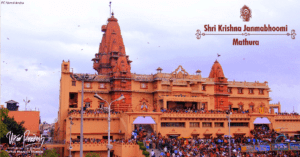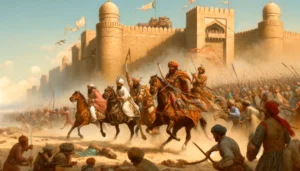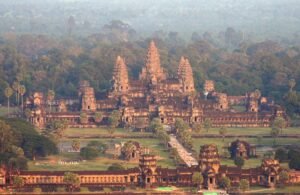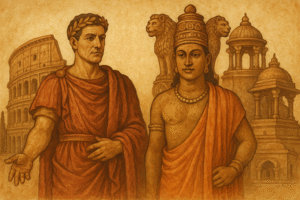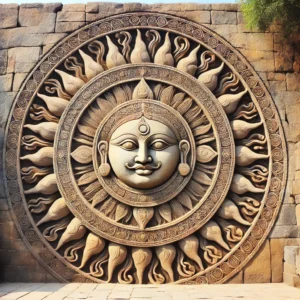The Chalukyas and Pallavas: A Tale of Rivalries and Innovations
Indian history between the 7th and 10th centuries CE was marked by remarkable political rivalries and cultural efflorescence. Among the most notable of these rivalries was the enduring conflict between the Chalukyas of Badami and the Pallavas of Kanchipuram. These two South Indian dynasties not only shaped the political landscape of the Deccan and Tamil regions but also left behind an enduring legacy of architectural, artistic, and cultural innovations.
In this article, we explore the political struggles, military campaigns, and cultural contributions of the Chalukyas and Pallavas, underscoring their significance in early medieval Indian history.
The Rise of the Chalukyas and Pallavas
The Chalukyas of Badami
The Chalukyas were one of the most prominent dynasties of early medieval India, emerging in the 6th century CE. Their first significant ruler, Pulakeshin I, established Badami (in present-day Karnataka) as their capital. However, it was under Pulakeshin II (r. 610–642 CE) that the Chalukyas reached the zenith of their power.
Pulakeshin II extended the Chalukyan empire across the Deccan plateau, defeating the Kadambas, the Mauryas of Konkana, and even successfully repelling Harsha’s northern ambitions. His reign marked a period of great political stability and cultural growth, with the Chalukyas patronizing art, literature, and architecture.
The Pallavas of Kanchipuram
The Pallavas, contemporaries and rivals of the Chalukyas, rose to prominence slightly earlier. They ruled from their capital at Kanchipuram (in present-day Tamil Nadu) and were known for their military prowess and patronage of Shaivism. Mahendravarman I (r. 600–628 CE) and his son Narasimhavarman I (r. 630–688 CE) were two of the most notable rulers of the Pallava dynasty.
The Pallavas are credited with initiating the Dravidian style of temple architecture and fostering a vibrant literary and cultural tradition in Tamil Nadu. Their rivalry with the Chalukyas defined much of South Indian politics during this era.
The Chalukya-Pallava Rivalry
The Battle of Vatapi
The most dramatic chapter in the Chalukya-Pallava rivalry unfolded during the reigns of Pulakeshin II and Narasimhavarman I. Pulakeshin II initially defeated Mahendravarman I and consolidated Chalukyan control over the northern Tamil region. However, Narasimhavarman I sought to avenge his father’s defeat.
In 642 CE, Narasimhavarman I led a successful campaign against Pulakeshin II, capturing the Chalukyan capital of Vatapi (modern-day Badami). This victory earned him the title “Vatapikonda” (Conqueror of Vatapi). The Pallava triumph was a significant blow to Chalukyan prestige, although the rivalry continued for several decades.
Military Innovations and Strategies
The Chalukya-Pallava wars were characterized by advanced military strategies and the use of cavalry and elephants. Both dynasties maintained strong standing armies and relied on well-fortified cities like Badami and Kanchipuram to secure their territories. These conflicts not only shaped the political boundaries of South India but also influenced the development of military infrastructure and strategy in the region.
Architectural Contributions
Chalukyan Architecture
The Chalukyas are renowned for their contributions to Indian temple architecture, particularly the development of the Vesara style, which blended Dravidian and Nagara elements. Notable examples include:
- Badami Cave Temples: These rock-cut temples, carved into sandstone cliffs, display exquisite sculptures of Hindu deities like Vishnu, Shiva, and Mahishasuramardini. The intricate carvings reflect the artistic prowess of the Chalukyan artisans.
- Aihole and Pattadakal: Known as the “Cradle of Indian Temple Architecture,” Aihole features over 100 temples showcasing diverse architectural styles. Pattadakal, a UNESCO World Heritage Site, includes temples like the Virupaksha Temple and Mallikarjuna Temple, exemplifying the maturity of Chalukyan architectural traditions.
Pallava Architecture
The Pallavas were pioneers of Dravidian temple architecture, which later influenced the Cholas and other South Indian dynasties. Key contributions include:
- Mahabalipuram (Mamallapuram): The group of monuments at Mahabalipuram, including the Shore Temple and the Five Rathas, are masterpieces of Pallava architecture. These monolithic structures demonstrate remarkable craftsmanship and an understanding of spatial composition.
- Kanchipuram Temples: The Kailasanatha Temple in Kanchipuram, built by Narasimhavarman II, is a stunning example of early Dravidian architecture. It features intricate carvings and is dedicated to Lord Shiva.
Cultural and Artistic Achievements
Literature and Language
Both the Chalukyas and Pallavas were patrons of literature, contributing significantly to the development of Sanskrit and regional languages like Kannada and Tamil.
- Chalukyan Contributions: Kannada literature flourished under the Chalukyas, with poets like Ravikirti composing inscriptions in praise of their rulers. Sanskrit works, including historical accounts and religious texts, also received royal patronage.
- Pallava Contributions: Tamil literature thrived under the Pallavas, particularly devotional works by the Nayanars (Shaivite saints) and Alvars (Vaishnavite saints). Mahendravarman I himself was a scholar and playwright, composing the Sanskrit farce Mattavilasa Prahasana.
Sculpture and Iconography
The Chalukyas and Pallavas also excelled in sculpture and iconography, leaving behind an array of finely carved statues and reliefs. These artworks often depicted scenes from Hindu mythology, reflecting the religious fervor of the time.
Religious Patronage
Both dynasties were devout patrons of religion, supporting Shaivism, Vaishnavism, and Jainism. Temples built during their reigns not only served as centers of worship but also as hubs of education, art, and culture.
- Chalukyan Patronage: The Chalukyas primarily supported Shaivism but also encouraged Jainism and Vaishnavism. The Jain caves at Badami stand as a testament to their religious inclusivity.
- Pallava Patronage: The Pallavas were ardent Shaivites, as evidenced by the numerous Shiva temples they constructed. However, they also supported Vaishnavism and Buddhism, promoting a syncretic religious tradition.
Decline and Legacy
The Decline of the Chalukyas
The Chalukyas faced internal dissent and external pressures from rising powers like the Rashtrakutas, leading to their eventual decline by the late 8th century CE. However, their cultural and architectural legacy lived on, influencing subsequent dynasties like the Hoysalas.
The Decline of the Pallavas
The Pallavas’ power waned in the 9th century CE, as they were overshadowed by the Cholas. Despite their political decline, their contributions to temple architecture and Tamil culture continued to inspire generations.
Shared Legacy
The rivalry between the Chalukyas and Pallavas spurred a cultural renaissance in South India, leading to significant advancements in art, architecture, and literature. Their achievements laid the foundation for the Cholas and other South Indian dynasties to build upon, shaping the region’s history and identity.
Conclusion
The Chalukyas and Pallavas were more than just rivals; they were architects of South India’s golden age. Their military campaigns, political strategies, and cultural contributions created a legacy that endures to this day. By fostering innovation in temple architecture, literature, and the arts, these dynasties not only shaped the history of their era but also left an indelible mark on India’s cultural and historical landscape.

